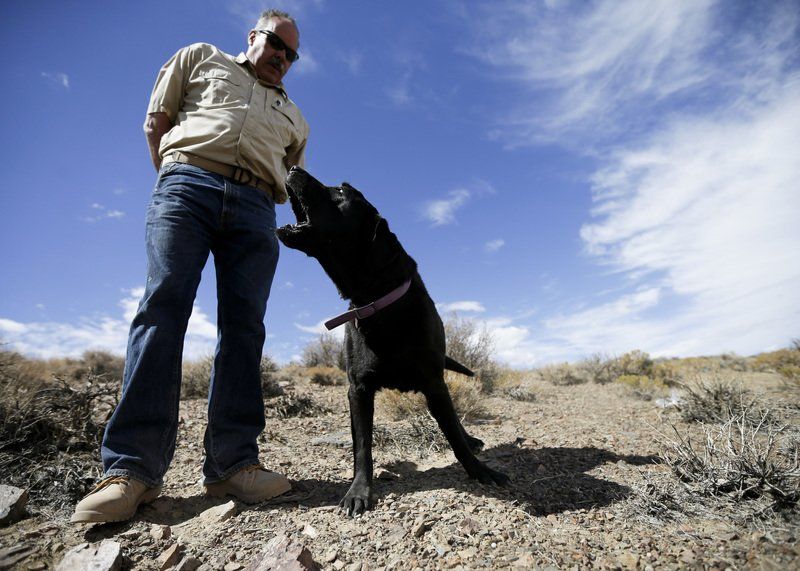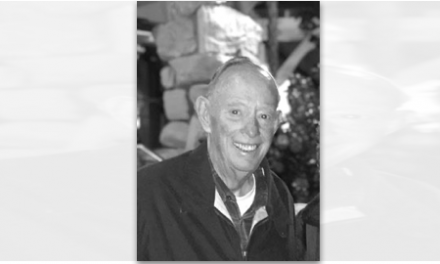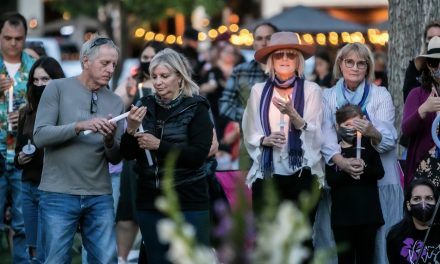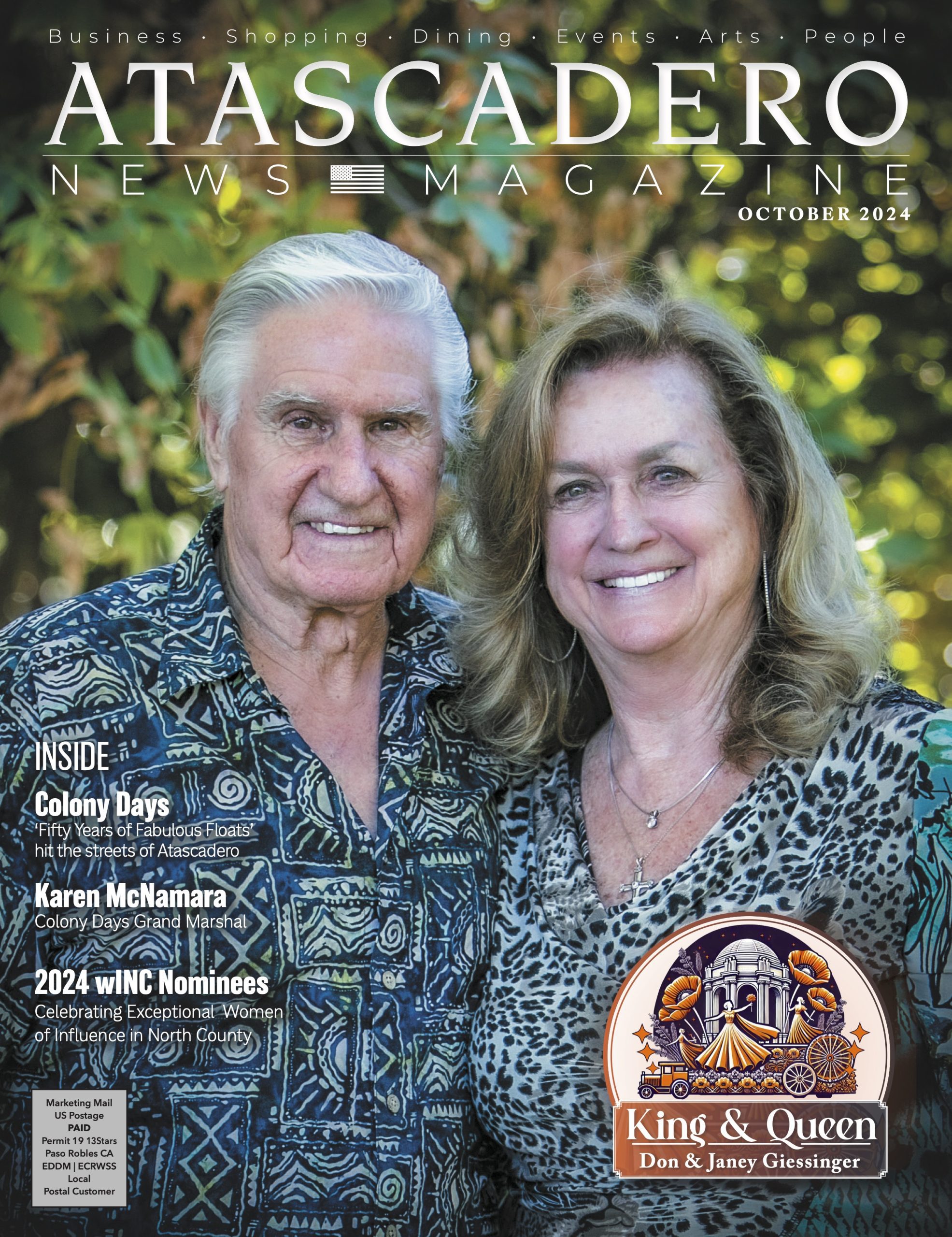Paul Dostie and Buster the Cadaver Dog
There is always more than one side to a story, especially when it comes to an unsolved case.
When it comes to the Kristin Smart case, “whodunnit” was never the question—no matter how long it took to arrest Paul Flores—the prime suspect and last person seen with Kristin back in 1996.
The question that still remains is—where are Kristin Smart’s remains?
If you ask retired police detective turned cadaver dog specialist Paul Dostie, he will tell you without any doubt in his mind that Kristin Smart’s remains are in the corner of Susan Flores’s backyard.

Buster passed away at 12 years old in February 2015 after finding over 200 human remains throughout his career as a cadaver dog. Contributed Photo.
Who is Paul Dostie and Buster
Paul Dostie retired in 2009 from Mammoth Lakes Police Department, where he worked as a detective sergeant on the narcotics task force. He worked in law enforcement for 30 years.
But Dostie didn’t know much about cadaver dogs until a homicide case he worked on in 2006 when a narcotics dog handler mentioned training a cadaver dog when she retired. Immediately Dostie knew as an investigator a cadaver dog could be an immense help to him.
By 2007 Dostie began training his new black labrador, Buster, in detecting human remains. Dostie reached out to Cadaver Dog: K9 Specialty Search Associates for cadaver trainers. As a result, Buster became State Certified in Cadaver and Avalanche Rescue.
The two assisted on a search at the Barker Ranch—a ranch located in Death Valley, infamously known for its association with Charles Manson and his “family.”
For years, Dostie has done work on the Barker Ranch and even spoke to Manson throughout his investigations there.
Later, Dostie became involved with History Flight—a privately operated 501(c)3 Non-Profit organization dedicated to researching, recovering, and repatriating America’s service members back to the United States.
Members of History Flight work to find individuals who have been listed as Missing in Action (MIA) or deemed non-recoverable from WWII, the Korean War, the Cold War, and the Vietnam War.
Dostie and Buster went on seven History Flight missions—three in Tarawa and four in Europe. Buster himself is accredited with finding over 200 human bodies. But, their most successful mission was in Tarawa, where Buster located over 35 WWII U.S. Marines lost after the Battle of Tarawa 72 years ago.
In an interview with Paso Robles Press, Mark Noah, the founder of History Flight and director of the Tarawa project, said he put Buster and Dostie through some accuracy tests in Tarawa before doing an official search.
He brought Dostie and Buster to another island of Tarawa, where only he knew there were no graves. Dostie came back saying there were no remains there.
Next, he brought the duo to an area where he knew there were recently recovered graves. Buster alerted right on top of grave sights where two Marines were recovered the year before.
After passing the tests, Noah and his team brought Buster and Dostie to some areas with known historical correlation to American graves, but no graves had been found yet.
After excavation, Noah’s team realized they found the largest missing grave recovered since WWII.
In the History Flight Search, Recovery and Identification Report 45 LT Alexander Bonnyman Jr. Betio, Tarawa, Republic of Kiribati 2006-2015, a map shows where Buster alerted and where remains were found.
Noah uses several methods when searching for burial sites—all used to cross-reference each other. He said cadaver dogs play a significant role for them and are used frequently in their searches.
“It was fascinating to be able to combine all the different levels of technology, including the dog alerts. And it was very rewarding at the same time because we found what we were looking for,” said Noah.
Buster alerted under 12 inches of at least three burials in the site pictured. Additionally, he alerted within three feet of 44 burials. But the findings didn’t stop there.
In total, over 100 American remains were found where Buster alerted.
Noah said, “He [Buster] alerted within six inches of the biggest recovery of MIAs that’s been done since WWII. You can’t dispute it.”
Within these discoveries, Buster alerted next to a building with a concrete slab. Twelve U.S. Marines were found under the building.
During these searches, Dostie was not told whether they knew or not there were remains there.
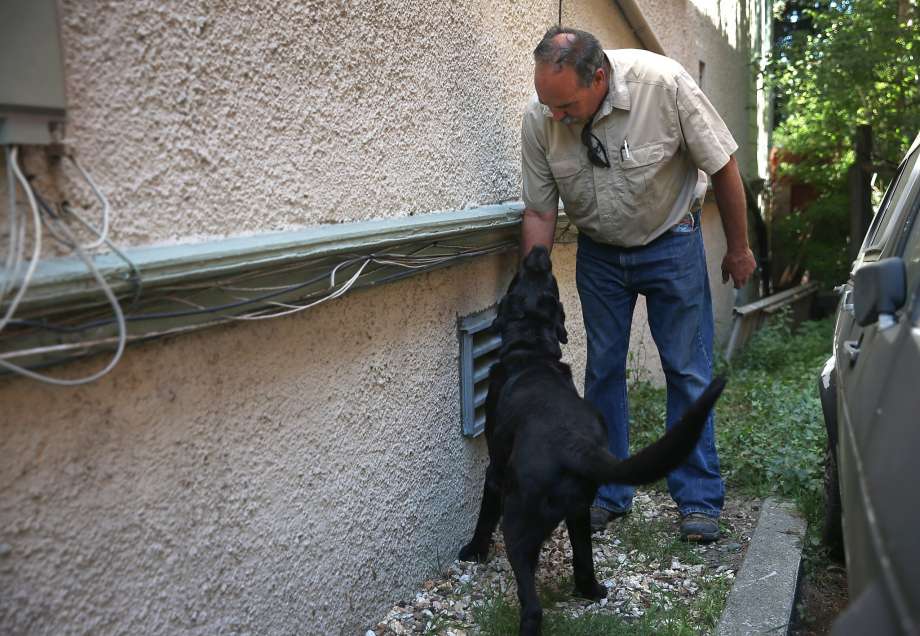
Dostie and Buster during a search on the Island of Tarawa. Contributed Photo. 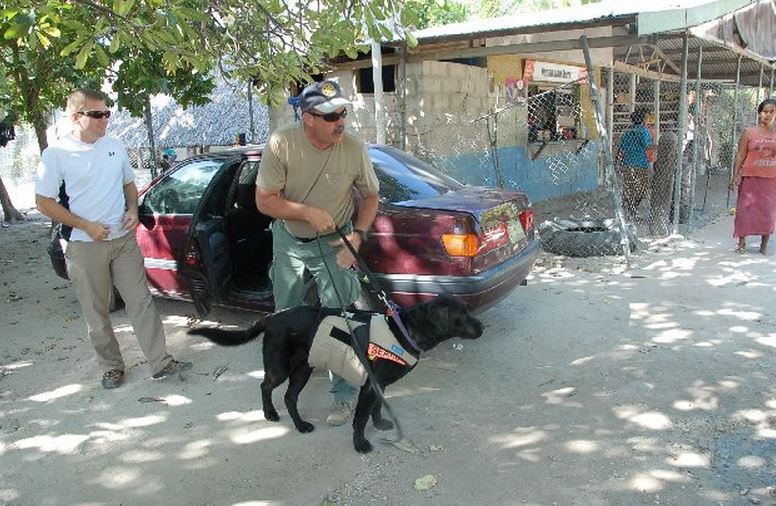
Dostie and Buster searching for missing girl in Oakland, CA. Contributed Photo.
The Science Behind Cadaver Dogs
The Barker Ranch investigations were how Dostie got in touch with Dr. Arpad Vass, a world-renowned research scientist and forensic anthropologist specializing in human decomposition.
He famously testified in the Casey Anthony case in Florida. Additionally, Vass was Tennessee Scientist of the Year in 2004 and is an instructor at the National Forensic Academy.
Vass is currently developing technology to locate clandestine graves by the use of odor mortis. There are typically seven stages of decay: pallor mortis, algor mortis, rigor mortis, liver mortis, putrefaction, decomposition, and finally, skeletonization. In addition, Dr. Vass has developed another category called odor mortis.
Vass’s technology works similarly to cadaver dogs.
According to the National Center for Biotechnology Information (NCBI) Human remains detection dogs (HRDDs) are “canines specially trained to find human decomposition scent and alert their handler to its location.”
During decomposition, humans release specific chemicals that essentially “plume” through the soil. Over time, these chemicals spread through moisture in the soil.
If trained properly, dogs can detect these chemical plumes and only detect those human scents–not mistaking them for other animal bones.
Together, Vass and Dostie have used each other almost as a cross-reference. For example, if Dostie’s dog makes a hit, he collects soil samples and sends them to a lab for Vass to later read the results for traces of volatile organic compounds (VOCs) referred to as odor mortis.
These tests search for chemicals specific to humans. So if Vass finds human-specific chemicals in the soil sample, that means there are human remains in the area.
Unlike most cadaver dogs, Buster was trained to detect clandestine graves–an unrecorded burial grave. Dostie trained Buster in 100-year-old cemeteries in Nevada and used techniques from bomb detection dogs.
In recent years, canines have been used in archeological searches. Archeologists put cadaver dogs to similar tests that Noah performed in Croatia. Those same dogs ended up helping archeologists find 3,000-year-old graves in Croatia.
The First Search
On Jun. 2, 2014, Paul Dostie’s cadaver dog Buster made his first hit for human decomposition around the perimeter of 529 East Branch Street in Arroyo Grande–the home of Susan, Paul Flores’s mother.
Dostie and David Smallwood of the California Register newspaper were given permission to search the yard directly in the back of the Susan Flores home. We will refer to this property as Lot 29.
Dostie’s sister, who lives in Atascadero, mailed her brother a copy of The California Register and mentioned he should consider looking into the case.
After reading the paper, Dostie said he was thoroughly impressed with the amount of detail put into the articles on Kristin Smart. So Dostie contacted Smallwood, and soon a plan was set to search for Kristin’s remains.
The two men arrived at Branch Street around 1:45 p.m. Buster was brought to the backyard of Lot 29. Dostie commanded Buster to “go find,” and the canine did as trained.
It didn’t take long for Buster to make a strong alert to the back corner of the fence line bordering Susan’s property.
Buster spun around and locked up like a bird dog alongside the fence bordering Susan’s home. After analyzing Buster’s reaction, Dostie said it was clear there was human decomposition there.

Buster making an alert next to Susan Flores’ home. Contributed photo.
Dostie and Smallwood then proceeded back to the truck to get the glass vials and tools to obtain a soil sample for Dr. Arpad Vass to analyze later. However, the two were prevented from returning to the backyard by the home’s owner (it turned out permission was given by a roommate and not the owner of the home).
Not long after Dostie and Buster were heading home, Smallwood called saying he got permission from the owner at another neighboring property, Lot 27.
Dostie turned around and got ready to obtain a soil sample. But, unfortunately, Buster did not go with him so as not to wake the neighbors if he were to bark. It was now about 11:00 p.m. Soil samples were then retrieved from the backyard corner bordering Susan’s home.
Later, Dostie mailed the soil samples to Dr. Vass in Tennessee to be analyzed for human decomposition. After two weeks, the sample results came in with a “weak positive” result.
According to Smallwood, from there, he took the information to Mark Connely, one of the Smart family’s attorneys. Connely reportedly said he would take those results and findings to the sheriff.
According to Smallwood, they were told the sheriff’s office did not look further into the findings, stating the evidence was insufficient to obtain a search warrant.
However, cadaver dogs were used in the early days of the case in Paul Flores’s dorm room.
Three dog handlers were brought in to testify during the preliminary hearing for Paul and Ruben Flores in August 2021.
Adela Morris, Gail LaRoque, Wayne Behrems, and their dogs participated in searching Paul Flores’s dorm room at Cal Poly in 1996.
Morris testified that her dog alerted to a door on the left side of Santa Lucia Hall, specifically room #128–Paul Flores’s dorm room. In addition, Morris said both her dogs, Cholla and Cirque, strongly alerted to the mattress and desk on the left side of the room.
LaRoque had a similar testimony regarding her dog Torrey who alerted to the same areas, including Paul Flores’s trash can.
Behrems and his dog Sierra also had the same findings.
All three handlers testified that they knew Kristin disappeared but did not know any further details on the case.
The Second Search
On Friday, Aug. 1, 2014, Buster and Dostie returned to Arroyo Grande for another search.
Buster returned to search Lot 27. Again, Buster quickly picked up on the scent of human decomposition. According to Dostie, the stronger the scent, the stronger the alert.
Once again, Buster gave a strong alert to a spot along the fence bordering Susan’s backyard. Buster then laid down, claiming that spot as an area containing human remains.
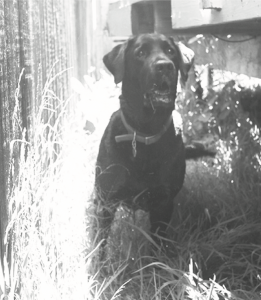
“It was like he ran into a brick wall. It was so strong,” said Dostie.
Following the procedure, Dostie took a soil sample from the spot to send to Dr. Vass for further testing.
On Sept. 18, 2014, test results came back from Dr. Vass indicating a negative for human decomposition.
It is believed by Dostie and Dr. Vass that migration of bio-markers in the soil was being impeded by the block wall and/or concrete footer supporting the wall.
It was also believed that the first sample was taken at a shallower depth, which resulted in a weak positive due to vegetation drawing bio-marker chemicals through cracks in the wall of the footer.
In plain man’s words–traces of human decomposition may be closer to the surface than at lower depths.
Essentially, if human remains are encased in concrete, over time, the bio-markers will escape through cracks and porous holes in the concrete and then migrate through the soil.
What We Know
We know when police interviewed Paul Flores on Jun. 19, 1996, he left early to finish concrete work at his mother’s home on Branch Street.
Then, when Mary and Joe Lassiter signed papers to rent and move into the Branch Street home in June 1996, they were told they could not move in until July because a concrete project in the backyard was not finished yet.
In a deposition with Attorney James Murphy, neighbors of Susan Flores said they noticed Paul and Ruben doing work in Susan’s backyard not long after Kristin’s disappearance. After, there were new latticework and planter boxes that had been cut out of existing cement.
In another deposition with Murphy’s Office, Joe Lassiter said one of the planter boxes measured six feet long by three feet wide. He added that he could not get flowers to grow in the box due to the second layer of cement underneath.
Then, in March 1997, Susan Flores’s backyard is searched using Ground Penetrating Radar (GPR). The GPR search geologist said he found an anomaly under the cement but told police he thought it was likely naturally made.
GPR detects anomalies in the ground—in other words, it shows spots in the soil that have been disturbed. For example, a hole that was dug and then covered up again.
However, he also said that he had never searched for human remains before and did not have the proper equipment. He also noted concerns over broken cement pieces that he was told were leftover from Paul and Ruben’s work the summer before.
Susan’s home was searched again on Jun. 19, 2000. Another search is done with GPR but comes up inconclusive.
This search was done after FBI agent Jack Schafer gave the SLO police department a warrant to dig up Susan Flores’s backyard.
Schafer was assigned to the Smart case. He said he went through the case files with a fine-tooth comb. Everything he found led him to Paul Flores being the prime suspect and Kristin’s remains at Susan Flores’s home.
In an interview with Paso Robles Press, Schafer said, “I gave them the opportunity to dig up the backyard, but they didn’t do it.”
And again, Susan’s backyard was searched in March 2007 using GPR. Professor Lawrence Conyers was able to search almost all of Susan’s backyard.
Conyers was not given permission to search the cement planters. He also concludes they could not search the West side of the home because of too much stuff in the way.
He was also unable to search a garage building that was built on the East side of the home in 1997 because of wire mesh in the floor. At the time of his search in 2007, there was no technology that could read through the metal wiring. But now there is.
The East side of the home was not properly searched because of this. It is also the same area where the Lassiters found an earring with what they believed to be blood on it. It is also where dogs alerted to the same spot a metal trash can sat that Ruben insisted on picking up while the Lassiter’s lived there.
The West side of the home is the same side, where the Lassiters heard the watch beeping and where the six feet by three feet cement planters are.
The West side of the home is also where Paul Dostie’s cadaver dog Buster alerted to human remains—twice.
Then, in 2021 the SLO County Sheriffs searched Ruben Flores’s home on White Court. From those searches, they claim to have found physical evidence of human remains and that those remains were moved.
Schafer speculates that evidence was found at Ruben’s home because, after Kristin’s disappearance, the Flores family put her there, only to later move her to Susan’s home that summer when Paul and Ruben did the concrete work.
Schafer also speculates that Kristin’s remains are still in Susan’s backyard.
He says, “I put my heart and soul into that case, and I thought we were going to get the body. That’s one case that got away.”
We have reached out to Mark Connely for comment but have not received a response.
The San Luis Obispo Sheriff’s Office said, “As a result of Judge Van Rooyen’s suppression order, in this case, the Sheriff’s Office is unable to comment at this time.”
Resources:
Cadaver Dogs
https://www.ncbi.nlm.nih.gov/pmc/articles/PMC7401519/
Smithsonian Magazine

